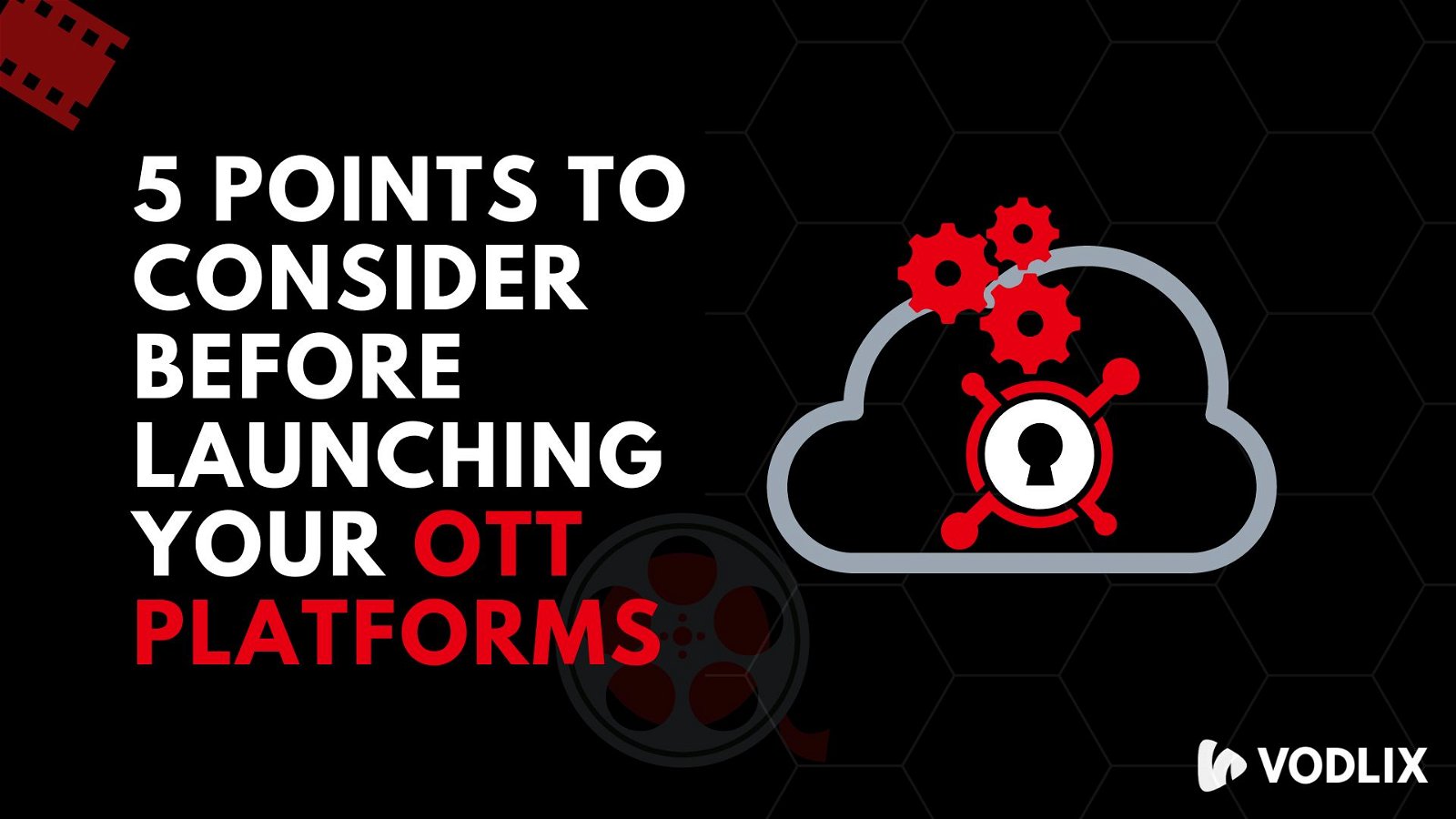
5 Points to Consider before Launching your OTT Platforms
This article provides 5 key factors that should be considered before launching an OTT platform, including content strategy, monetization, and user experience.
November 3rd, 2022

Launching your OTT Platforms
The OTT industry has a huge potential for growth. People are switching more to online channels for entertainment. As per ComScore, around 50 million households across the world have OTT videos that they consume in a similar time-of-day pattern as traditional TV viewers. For quick functionality and quality of experience of the OTT platform, we have formed 5 powerpack points to consider:
Find your Cloud
Ability to adapt in the wild
Monetize before you digitalize
CDN – Delivery of Content
Free Updates and Maintenance
1. Find your Cloud
As we all are well aware in order to use the OTT platform, we need to manage massive data, and for that massive data management system is required. Obviously, a cloud-based system is an absolute choice and we recommend it to our clients for high-quality content delivery. It provides end-users instant and endless access to a content-rich repository. Similarly, we can leverage SaaS options or engineer a proprietary solution.
While talking about SaaS, AWS is a powerful data storage device option available in the market. Through a cloud-based system, you can get the secure sustainability and accessibility of the data. Concurrent users can access the same content at the same time and from the same account.
2.Ability to adapt in the wild
The adaptability of the OTT platform is the utmost important factor in the success of the platform. We all are looking for first-rate development, engineering a custom, scalable solution, rather than a one-size-fits-all.
In the OTT world, cross-platform support, multiscreen support, a sleek frontend, an elastic backend, a load-bearing backend, dedicated endpoints, and proprietary APIs are needed. That is why frontend and backend need to be developed in an equally smart way that ultimately leads to streaming protocol and UI/UX.
OTT servers act as an index alternating between versions according to bandwidth for variant streams as per their adaptable nature.
3. Monetize before you digitalize
Revenue generation is the ultimate goal of every business. With the OTT solution, you can have multiple revenue streams as they have multiple monetization models that include AVOD, TVOD, and SVOD.
AVOD is a freemium model as it is an ad-supported service. Ad-based income relies on viewership. Platforms that have the AVOD model have an evolving network of users who are willing to sit through ads for access to the content of their choice.
Viewers accept this trade-off as they are not paying anything for the content they are consuming. They know that content is delivered at a certain standard and will be delivered immediately after the ad cycle. One of the best examples of the AVOD model is YouTube.
TVOD is a transactional service that works on a pay-per-view basis, a la carte OTT content. Users have to pay a single fee to binge-watch whatever they please without racking up an enormous bill. TVOD is meant to be a fine dining experience where you get what you order and nothing more.
TVOD tends to offer more selective viewing experiences to keep customers engaged and buying. Amazon Video rentals are the perfect example of the TVOD monetization model.
SVOD is a subscription-based monetization model which is similar to the all-you-can-eat buffet of OTT. This model purely depends on the large network of subscribers.
It is a convenient service that allows its users to sign up conveniently as it is equally convenient to cancel the subscription at any time. SVOD model fits perfectly for every type of consumer including users who watch an exuberant amount of content, who watch hardly any content at all, and the bulk of subscribers who consume content at a leisurely rate.
In most cases, OTT platforms use a hybrid model to maximize their profit and open all possible revenue streams. And for that, you need to define your viewership and how you plan to capitalize on their demands before building an OTT platform. However, you can get the best Netflix clone in the 6 simplest steps with Vodlix.
4. CDN – Delivery of Content
The next major aspect to consider is the Content Delivery Network which is a web of services to deliver content to users when they make a request. You can buy or build CDN as per your requirements.
If you are building your own CDN, you can have complete control over your delivery and control scalability issues without compromising playback quality. However, you can buy or acquire cloud-based CDN for consistently encrypted, personalized, and cached properly, and completely relevant content to user requests.
5. Free Updates and Maintenance
Updates and maintenance of the apps are a continuous process. It is highly important to consider the platform that offers updates to your apps to the latest version for free. Your website and apps get maintenance through updates hence you need to buy the package that offers Free updates and maintenance. Otherwise, you need to be prepared for the maintenance of the apps and websites.
Summing Up
Choosing the right OTT provider depends on your professional broadcasting needs and it requires a bit of thought and consideration. We suggest you map out the features that direct your goals and make a comparison of the offered features provided by your top choices. Also, you need to pay close attention to security, technical support, and price. You need to know that your OTT provider has got your back and fits into your budget.
Vodlix – an Ultimate OTT Platform Provider that enhanced security and advanced monetization tools with powerful CMS for organizing content. You can schedule a 14-day free trial to test out all the features.
Liked what you just read?
Subscribe to get the latest news, strategies, and insights on membership businesses delivered straight to your inbox.
Thank You for Subscribing!
We've successfully added you to our mailing list. You'll receive our latest updates and insights straight to your inbox.
By subscribing, you agree to receive occasional marketing emails from us. You can unsubscribe anytime with a single click.
This site is protected by reCAPTCHA, and Google's Privacy Policy and Terms of Service apply.

.png)



